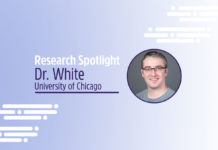
This week’s Research Spotlight focuses on Luke Mansfield, a Ph.D. candidate from the Oncology and Metabolism Department of the University of Sheffield. His research currently uses zebrafish as a model for aging. He also works at a private company helping develop novel pharmaceuticals from plant extracts.
Discovering the clues for human aging in smaller organisms
When I spoke to Luke Mansfield, he was focused on investigating immune cell aging using zebrafish as a model organism.
“My project was attempting to improve the health of the immune system in aged zebrafish to see if it would aid in the clearing of senescent cells. Originally it was focused on macrophages, but complications with our transgenic fish led to it being a broader immune system study.” When I asked what made him want to focus on macrophages initially, he explained that it was because “there is some evidence they clear senescent cells in the body.” In fact, his initial interest in aging stemmed from the immune system. “I found the immune system interesting while I was doing my undergraduate degree, and then I discovered the field of aging in my final year, so the chance to combine the two was ideal. Long term, I’m aiming to find ways to reduce the senescent cell burden of the aged body while enhancing immune regulation, which macrophages are a key part of.”
When I asked what types of interventions he envisions for his research using zebrafish, he cited “most likely an RNA or small molecule that would promote translation of a specific protein, though I cannot comment on which protein yet, at least not until the study is published.” He noted that zebrafish are an ideal model to test potential therapeutics because “we can look at markers of aging like muscle density, spinal deformation, and plot a survival curve of the population. We are looking at phagocytosis assays to determine their effectiveness as well as next-generation sequencing of the experimental fish to determine how their transcriptome has changed compared to untreated specimens.”
Industry vs academia
Mr. Mansfield also mentioned that he works for a small start-up company developing pharmaceuticals derived from plant extracts. I asked him for his thoughts on academic and industrial labs, both known for being very different work environments.
“Academia is a mixed bag, to be honest. On the one hand, it’s great in the pure sense that we strive to discover the unknown using the scientific method and that people are willing to work together to answer complex questions the answers that could benefit humanity as a whole. On the other hand, it’s a tough place to work. It’s expected that you devote your life to it. This, combined with the publish-or-perish mentality, funding issues, and the ethical dilemmas they present, can make it quite demoralizing. For my part-time work at the start-up, the experience is a relaxed one. There is still pressure to do work and meet deadlines, but the attitude is more ‘let’s do this experiment, if it’s a positive result, then great, and if it’s negative, that’s just how it goes,’ whereas, in academia, you can’t publish negative results. However, working in industry you are at the beck and call of investors, and you won’t get to choose your research projects so much, so you lose that independence that academics value so much.”
Lab management was a particular area of interest that differed between academia and the industry. “In my Ph.D. lab, we have the PI and a postdoctoral research assistant who manage the lab, and all work is recorded in paper lab books. Digital raw data is backed up on Google drive because it’s the university’s policy, but using a LIMS is not common practice in my experience, which can make going over old notes slightly arduous. As with many academic labs, they can be constrained by the policies of the research institution they are associated with. However, those research institutions have to look after hundreds of researchers from different fields, so they may have to compromise for something that works for everyone. In the industry, we have paper lab books for rough notes and recording, but we also have a LIMS for lab work recording and analysis, as well as cloud storage for data backup. Because the company is designating its own research practices in a narrower field, it has more flexibility in terms of how it wants to manage its data. On the other hand, this can be bad as some companies become slack in their safety, I’ve heard of companies without COSHH assessments or much H and S to speak of.”
Extracurricular activities
After a little digging, I managed to find out that Mr. Mansfield has a very creative and interesting extracurricular activity, something anyone who reads and loves Harry Potter would get on board with Quidditch. For those who have never read Harry Potter, Quidditch is a game where Hogwarts students fly around on broomsticks, trying to throw a ball through a hoop, while one member of each time, the seeker, chases down a Golden Snitch (a flying ball with wings). He offered up a great description of the real-life version of the game:
“You’ve got a keeper, two beaters, three chasers, and a seeker. The snitch is actually a person that has to be caught by the seeker, the beaters actually hold the bludgers and throw them at people, so it’s a bit like dodgeball crossed with rugby. And you have a broom you have to hold between your legs the whole time. I played chaser and occasionally beater if we were short a player. We went to the British Quidditch Cup once, which was 20 teams in brackets! Unfortunately, I think several teams folded when the J.K. Rowling drama occurred. They’ve changed the game’s name; it’s called Q Ball now. These days I play a full contact form of Celtic hockey called Shinty.”
The future of aging
Near the end of the interview, I asked Mr. Mansfield what he envisions for himself in the future and what he thinks will be emerging trends in aging research.
“If my data are successful, I’d like to see my research, in the long term, translated into clinical trials, so I’d take whichever route leads to that, but staying in research would be ideal. Or becoming a hermit somewhere when I run out of money/willpower. I think it’s important, with aging research, for the public to understand it’s not about making people live forever; it’s about people living healthier lives for longer. Imagine if you could give people a therapy that meant they had a reduced risk of cancer, heart disease, dementia, and all these pathologies that are associated with old age. Not only would people be healthier and more independent for longer, but it would save health care institutions lots of money.”
With so many compounds and potential anti-aging therapeutics in development, it can be hard for some to envision how they might one day become a common part of the pharmaceutical industry. I asked Mr. Mansfield what he thought needed to be improved in aging research in order eventually get there.
“I think the experimental design does need to be improved, but it’s going in the right direction. For example, recent clinical trials of senolytic drugs (meant to remove senescent cells) on people with idiopathic pulmonary fibrosis looked at improving their function, like VO2 max and physical fitness, so markers like that are good. There are scientists trying to determine reliable biomarkers for aging, which might be measured with anti-aging treatments. These include things like telomere length, markers of inflammation, and the small molecules excreted by senescent cells, known as the senescence-associated secretory phenotype. However, being able to clinically assess people’s age using a quick physical fitness test would be excellent as well.”
LabTAG by GA International is a leading manufacturer of high-performance specialty labels and a supplier of identification solutions used in research and medical labs as well as healthcare institutions.



